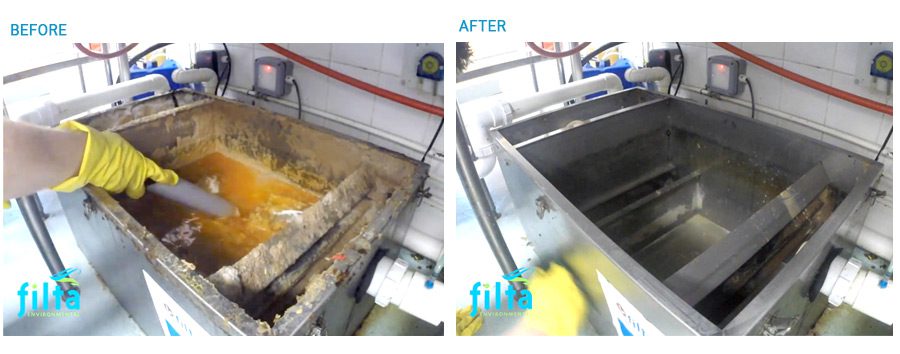Grease Trap Cleaning FAQ

Proper grease trap cleaning and maintenance is an essential part of a commercial kitchen’s grease management routine. If the trapped grease is not removed properly the FOG (Fats, Oils and Grease) collected will overwhelm the fat trap causing it to pass on into the drain line leading to blockages in local drainage and potential fatbergs in the sewer networks.
Below we outline some of the most frequently asked questions about grease trap cleaning and how Filta can assist with our grease trap cleaning services.
What are the Signs Your Grease Trap Needs to be Cleaned?
- Bad odours
- Slow draining sinks
- Fruit flies
- Grease build-up in areas that it shouldn’t – i.e. grease lines around sinks
- It’s been a while since your last grease trap cleaning – over 3 months
How Often Should Grease Traps be Cleaned?
The service frequency of grease traps depends on the volume of effluent passing through the unit as well as the size of the grease trap you have installed. Typical cleaning is on a 90-day basis, however this can be more or less frequent. A good way to tell if your grease trap needs cleaning is by the level of grease inside it, if it is more than 25% of the liquid then it’s time to empty it. If you neglect the cleaning of grease traps, this can cause any number of issues with your drainage and wastewater system. There is a limited amount of FOG that your grease trap can hold without contaminating the watercourse, if this limit is reached, then it will no longer be able to remove FOG from your drainage system, causing pollution which will leave you susceptible to fines as well as causing FOG to build up in your drains leading to blockages.
Filta’s expert engineers will be able to assess your grease trap and site usage to determine the frequency of your grease trap cleaning, this will then be used to create a grease management plan, which if followed correctly will help to ensure that your grease trap remains functional and your business remains open.
How To Clean a Grease Trap
When cleaning a grease trap, it’s essential to ensure that any FOG removed from the trap is disposed of correctly and that you possess the correct license to do so. Failure to dispose of this waste correctly can cause you all sorts of issues, including fines from the Environment Agency.
If you don’t have the required licensing for this disposal, then contacting a grease management company such as Filta is suggested. These companies should possess the correct licensing and will help you dispose of your FOG waste safely and legally. It’s important to note that even if you outsource this work, the waste is still your responsibility, and if it was found to be disposed of incorrectly by your sub-contractor then you can still be liable for this. Filta has all the correct licenses to carry and dispose of FOG waste, so you can have peace of mind that your grease trap cleaning servicing is done correctly and efficiently.
Filta Group are specialists in grease trap cleaning and maintenance. Using Filta’s specially developed grease trap cleaning process and equipment we carry out cleaning grease traps with minimal disruption to your operation. Our steps to clean a grease trap are:
- If needed, our engineers use Filta’s odour guard to control smells – this is particularly needed on grease traps that haven’t been maintained for a while
- Using a unique vacuum unit we remove all grease quickly and quietly – this will collect the majority of your waste in our sealed units, making it easy to dispose
- We clear all silt from the system – silt and food waste will settle at the bottom of the grease trap, we will ensure to remove all of this waste
- We clean and wipe down all surfaces – this helps to ensure your grease trap is completely clean and helps it to work efficiently
- We remove waste and provide a Waste Transfer Note – any waste removed from your grease trap will need a Waste Transfer Note as part of the Environment Agencies requirements
Grease Trap Cleaning Procedure
Before & After of One of Our Grease Trap Cleans

How Can You Stop a Grease Trap From Smelling?
Unfortunately, a bad part of FOG and food waste are smells, particularly if it is allowed to build up. One of the most important things you can do is to maintain your grease traps, this helps to ensure that the FOG doesn’t build up to unacceptable levels, causing bad smells.
Proper use of your drains can also help to maintain smells, reducing the amount of food waste that enters the drainage system will help to reduce the amount of FOG that builds up in your grease trap. It is also illegal or highly frowned upon to allow food and drink waste to enter the drainage system, and you can be issued a Section 111 notice from your local water authority if you’re found to have contaminated the water course. Therefore, it is best practice to ensure as much food waste as possible is removed from your crockery and disposed of in the correct food waste bins before it enters your sinks – this includes liquids such as milk, which are also renowned for causing issues in drainage systems.
If you have followed the above steps and you are still finding smells within your commercial kitchen, then there are other products you can use to manage the smells. Installing a dosing unit to work alongside your grease trap, will help to remove some of the smells. These dosing units work by releasing an enzyme into your drainage system at scheduled intervals, this biological drainage cleaner will work on breaking down the FOG in your drains, making it smaller and easier to manage.
Grease Trap Cleaning Specialists
One of our specialities at Filta is providing a reliable and robust grease trap cleaning service to commercial kitchens and businesses throughout the UK. With this managed service, businesses are assured that their grease traps will be properly maintained and, importantly, that they won’t fall foul of the Water Industry Act 1991. Make sure your business benefits from having a clean grease trap and give us a call on 01788 550 100 or contact us online for more info.
